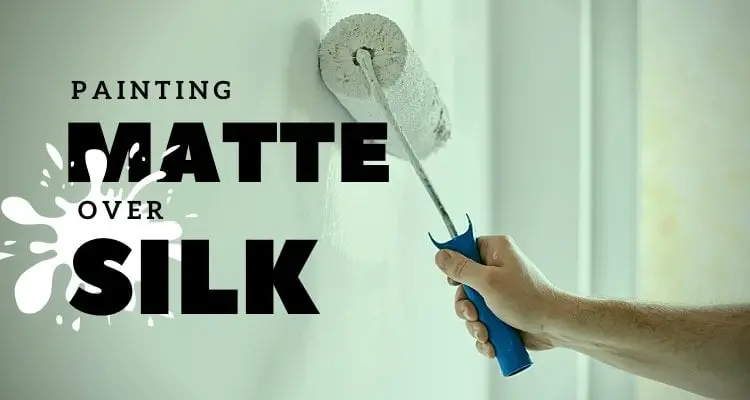You can paint matte over silk but it’s not as simple as painting straight on top of the old silk paint. There are a few steps you’ll need to take to prepare the surface so that the paint covers all the surface area without blemishes.
Learn what these are below, and make sure you’ve got some sandpaper!
What is the Difference Between Matte Paint and Silk Paint?
Along with color, paint is also labeled according to how much sheen/shine it has. From less shiny to shinier, they go matte, eggshell, satin, silk, and gloss.
So, as you can see, matte is considerably less shiny than silk. It provides a flat, low-shine, and can create a truly seamless look!
Matte
First, is it MATT or MATTE? 🙂 It’s the same thing really. People are using these terms interchangeably (plus the MAT variant)
Matte paint (also known as flat paint) has the least shine and reflects very little light. In fact, it’s fairly light-absorbent. This means that it can be used to hide flaws, such as holes or bumps, that a shinier paint would doubtlessly show.
As you can imagine, matte paint is quite popular. It can be used to create a flawless finish, making walls and ceilings look good as new.
It is best for larger spaces, like the living room and kitchen. This is because the low-light matte effect can potentially make small spaces look smaller.
Along with this, matte paint is not as durable as shinier paints are.
One of the drawbacks of matte paint is that due to its porous texture, it is more difficult to remove stains.
It’s a trade-off.
Eggshell
The runner up to matte on the low-sheen (low-luster) end of the spectrum is eggshell.
This paint has a similar ability to hide imperfections, and like matte, it’s often used in kitchens, dining rooms, and living rooms, where there is already plenty of light.
These are also the rooms folk most often like to show off.
Along with its naturally seamless appearance, eggshell paint is more durable than matte and resistant to picking up dust or dirt.
Satin
Satin paint has a subtle sheen, and like most shiny paints, it is very durable. It can stand up to scrubbing without showing much wear. This makes it ideal for those with children, as it makes wiping off crayons and food stains easier.
In fact, unlike matte or eggshell paint, satin paint is particularly water-proof. This makes it ideal for high-humidity areas, like the bathroom or kitchen.
As with any shiny paint, the main downside of satin is that it tends to highlight bumps, cracks, and other flaws.
Silk
Silk is a very shiny type of paint, (known as semi-gloss), and remarkably durable, too. It has a rather glossy surface that’s great at repelling dust and dirt.
It’s also resistant to scratches and other wear.
Because of its highly reflective nature, silk paint is usually used only in kitchens and bathrooms. It stands up excellently to the humidity, as it is remarkably water-proof.
Silk paint can also be used in high traffic areas and kids’ rooms due to its durability.
Silk paint also showcases flaws, causing bumps to shine, and dents to be comparatively dull. In this respect, it is not the most aesthetic-looking paint if your walls are less-than-perfect.
Gloss
Gloss paints are used to protect high-traffic walls from humidity and grime, such as the kitchen walls and cupboards, bathroom, etc. They leave behind an ultra-shiny residue, similar to lacquer.
Gloss paint is not usually used elsewhere in the home, as it can have a bit of an unsightly glare. Not only that, but flaws are virtually showcased by gloss paint.
Above all, it’s extremely durable and water-proof.
Gloss paint is rarely used on walls, being more suitable for doors, window frames, trims, as well as architectural features.
How Do You Paint Matt Over Silk?
It doesn’t matter if it’s drywall or plaster, in order to apply a new layer of matte paint to an old layer of silk paint successfully, you’ll first need to prepare the silk.
Otherwise, the matte paint will either go on unevenly, as it simply won’t stick.
Fortunately, the following 3 steps couldn’t be simpler.

- Sand the silk paint off (this will provide a ‘key’ for the matte paint to stick to).
Silk paint is naturally resistant to things that try to stick onto it, such as crayons, stains, or dirt.
This also means that it is not the easiest for other paints to adhere to. In order to achieve an opaque, even coat, you will need to sand a portion of the old, silk paint away first.
This can be accomplished with wet or dry 100-grit sandpaper. Using an electric sander will make this task much quicker and easier. - Clean the wall. Once you’ve sanded the silk paint down evenly, you’ll want to clean the wall.
Wipe it down with a damp rag, to remove any residual paint dust or other dirt. Otherwise, these will mix in with the primer or paint you apply (which can degrade its appearance or texture).
Afterward, make sure to completely dry the wall off. - Apply paint primer. Any paint, ideally, should be applied after a good primer.
Paint primer exists specifically to create a smooth, adhesive surface upon which to apply paint. It greatly increases any paint’s resistance to wear.
Simply put, it will make your new layer of matte paint look better, and last longer!
Apply Your Matte Paint
Now that you’ve prepared the silk paint layer to be painted over, and applied a primer, you can start applying your choice of matte paint.
You may notice some imperfections leftover from the sandpaper. Luckily, matte is one of the most forgiving kinds of paint you can work with; it naturally fills in small gaps and cracks, creating a seamless look.
Smooth, even brushstrokes should do the trick! This task can be made easier and faster by using a good-quality paint roller.
Why Paint Matte Over Silk?
So, why paint matte over silk, anyway? Perhaps you’re looking to change your home’s overall style. Or maybe you’re hoping to hide some small flaws a bit better.
Either way, matte paint is the answer.
In place of silk paint, matte paint can give a room an entirely new feeling, due to the level of light reflection (which is low). It will also provide a freshly lustrous coat of color.
While silk paint reveals the most flaws, matte paint covers most of them. It can be a real household refresher!
Summary
So, there you have it: painting matte over silk is not only possible, but it couldn’t be much easier.
Just take the proper steps and you can successfully cover that old, tarnished silky paint with a new, smooth, and beautiful coat of matte paint.
Ninja Team Members Working On This Page

Adrian – Web Master / Construction Professional
Construction Professional, driver, crane operator, handyman … As a construction pro I love to get creative and see things done with my hands coming to life. Here I share with you some of the things I learn and hopefully you’ll get something out of it. Enjoy 🙂








